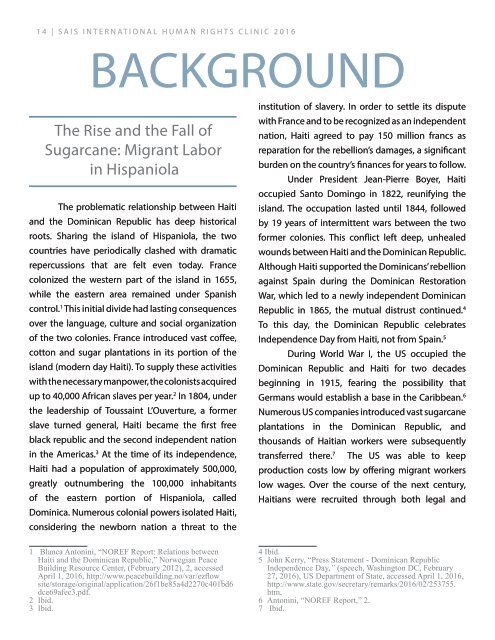Create successful ePaper yourself
Turn your PDF publications into a flip-book with our unique Google optimized e-Paper software.
14 | SAIS INTERN<strong>AT</strong>IONAL HUMAN RIGHTS CLINIC 2016<br />
BACKGROUND<br />
The Rise and the Fall of<br />
Sugarcane: Migrant Labor<br />
in Hispaniola<br />
The problematic relationship between Haiti<br />
and the Dominican Republic has deep historical<br />
roots. Sharing the island of Hispaniola, the two<br />
countries have periodically clashed with dramatic<br />
repercussions that are felt even today. France<br />
colonized the western part of the island in 1655,<br />
while the eastern area remained under Spanish<br />
control. 1 This initial divide had lasting consequences<br />
over the language, culture and social organization<br />
of the two colonies. France introduced vast coffee,<br />
cotton and sugar plantations in its portion of the<br />
island (modern day Haiti). To supply these activities<br />
with the necessary manpower, the colonists acquired<br />
up to 40,000 African slaves per year. 2 In 1804, under<br />
the leadership of Toussaint L’Ouverture, a former<br />
slave turned general, Haiti became the first free<br />
black republic and the second independent nation<br />
in the Americas. 3 At the time of its independence,<br />
Haiti had a population of approximately 500,000,<br />
greatly outnumbering the 100,000 inhabitants<br />
of the eastern portion of Hispaniola, called<br />
Dominica. Numerous colonial powers isolated Haiti,<br />
considering the newborn nation a threat to the<br />
institution of slavery. In order to settle its dispute<br />
with France and to be recognized as an independent<br />
nation, Haiti agreed to pay 150 million francs as<br />
reparation for the rebellion’s damages, a significant<br />
burden on the country’s finances for years to follow.<br />
Under President Jean-Pierre Boyer, Haiti<br />
occupied Santo Domingo in 1822, reunifying the<br />
island. The occupation lasted until 1844, followed<br />
by 19 years of intermittent wars between the two<br />
former colonies. This conflict left deep, unhealed<br />
wounds between Haiti and the Dominican Republic.<br />
Although Haiti supported the Dominicans’ rebellion<br />
against Spain during the Dominican Restoration<br />
War, which led to a newly independent Dominican<br />
Republic in 1865, the mutual distrust continued. 4<br />
To this day, the Dominican Republic celebrates<br />
Independence Day from Haiti, not from Spain. 5<br />
During World War I, the US occupied the<br />
Dominican Republic and Haiti for two decades<br />
beginning in 1915, fearing the possibility that<br />
Germans would establish a base in the Caribbean. 6<br />
Numerous US companies introduced vast sugarcane<br />
plantations in the Dominican Republic, and<br />
thousands of Haitian workers were subsequently<br />
transferred there. 7 The US was able to keep<br />
production costs low by offering migrant workers<br />
low wages. Over the course of the next century,<br />
Haitians were recruited through both legal and<br />
1 Blanca Antonini, “NOREF Report: Relations between<br />
Haiti and the Dominican Republic,” Norwegian Peace<br />
Building Resource Center, (February 2012), 2, accessed<br />
April 1, 2016, http://www.peacebuilding.no/var/ezflow_<br />
site/storage/original/application/26f1be85a4d2270c401bd6<br />
dce69afec3.pdf.<br />
2 Ibid.<br />
3 Ibid.<br />
4 Ibid.<br />
5 John Kerry, “Press Statement - Dominican Republic<br />
Independence Day,” (speech, Washington DC, February<br />
27, 2016), US Department of State, accessed April 1, 2016,<br />
http://www.state.gov/secretary/remarks/2016/02/253755.<br />
htm.<br />
6 Antonini, “NOREF Report,” 2.<br />
7 Ibid.


